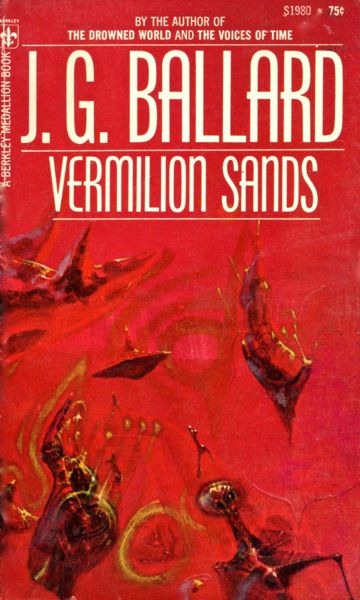

This is a collection of stories of humanity at some pinnacle (nadir?) of time when men and women devote their time to the arts. Elsewhere a reviewer described this as Ballard's only positive work.
In his preface, he writes the "heavens [of most SF stories] are like other people's hells" and that these stories display a desert resort where "work is the ultimate play and play the ultimate work"--a place he'd like to live. Ballard states this is his vision of the future although a commentary on the present.
For Judith Merril's Best SF 12, he wrote:
"Vermilion Sands is not in Arizona, or anywhere in the USA, not on another planet, which one or two people over the years have accused. Also, there is no sea here, although so many of the images, are marine--the beach ambiance, the sandrays, the reefs. This is a desert area, but so crystallized that it has almost produced a new fauna and flora of its own."
This is a bit odd since eight years later he would suggest Arizona is a spiritual ancestor--not backtracking, exactly, but it suggests his vision of it mutated, perhaps as he wrote the stories, or as he discussed them with others. Also, there's that strange, operative word "almost" which throws a monkey wrench into the sentence's ultimate sense.
Is his vision of the future positive? Most of his covers look post-apocalyptic, which may or may not have served the work, but why is it set at edge of a desert? Life may exist there, but sparsely. A desert seems to suggest life near the end of its tether. In his story, "Prima Belladonna" suggests that the life of the artist leads to a kind of death--real or not.
The arrangement of stories varied:
1971 Berkley Medallion:
- Prima Belladonna
- The Thousand Dreams of Stellavista
- Cry Hope, Cry Fury!
- Venus Smiles
- Studio 5, The Stars
- The Cloud-Sculptors of Coral D
- Say Goodbye to the Wind
- The Screen Game
The 1973 Jonathan Cape edition adds "The Singing Statues" and rearranges the order. I will assume this is the author's favored version since it appeared in this order afterward (although it's possible that the first edition order was closer to his original vision that was altered over time). The links go to commentary on individual stories:
- The Cloud-Sculptors of Coral D
- Prima Belladonna
- The Screen Game
- The Singing Statues
- Cry Hope, Cry Fury!
- Venus Smiles
- Say Goodbye to the Wind
- Studio 5, The Stars
- The Thousand Dreams of Stellavista
The 1975 Panther edition adds a preface but maintains the new order. Later editions tended to follow the Panther or Cape editions (with or without the preface). So this seems to be the standard.
Perhaps the anthologizing by Peter Haining and Judith Merril influenced his first conception. The descriptive writing of the later story "The Cloud-Sculptors of Coral D", though, is superior. Perhaps that sets a higher bar for the collection. I don't know that flipping the order of the first two stories of the later editions is critical. The current first story, Cloud-Sculptors, does elevate the language and probably does draw in more literate readers browsing through the bookstore, but perhaps Prima Belladonna does have its own strengths.
The real advantage on the new order is changing which story comes last. Putting "The Screen Game" last does suggest the deterioration of those resort town, and perhaps of art itself, a continuing thread, but "The Thousand Dreams of Stellavista" brings the art to the reader. A lot of the stories are at a kind of remove, outsiders viewing the main artists (even if the viewers might be artists themselves), but here it is clearly just an admirer of the art, who comes in, smitten, and exits profoundly changed.
I'm not sure that either story is the culmination of the works gathered here--and it is more of a collection than a solid work, so we shouldn't hold it to that level--but it does have a greater impact, emotionally and metaphorically than his first choice. Art may consume the artist as it seems to in a lot of these tales, but it doesn't often consume those who appreciate it. It shifts the frame and helps see the whole in a new light. It's interesting that Ballard had a fondness for the story--demonstrated by how he placed it second and last--when no one else chose to reprint the tale.

No comments:
Post a Comment